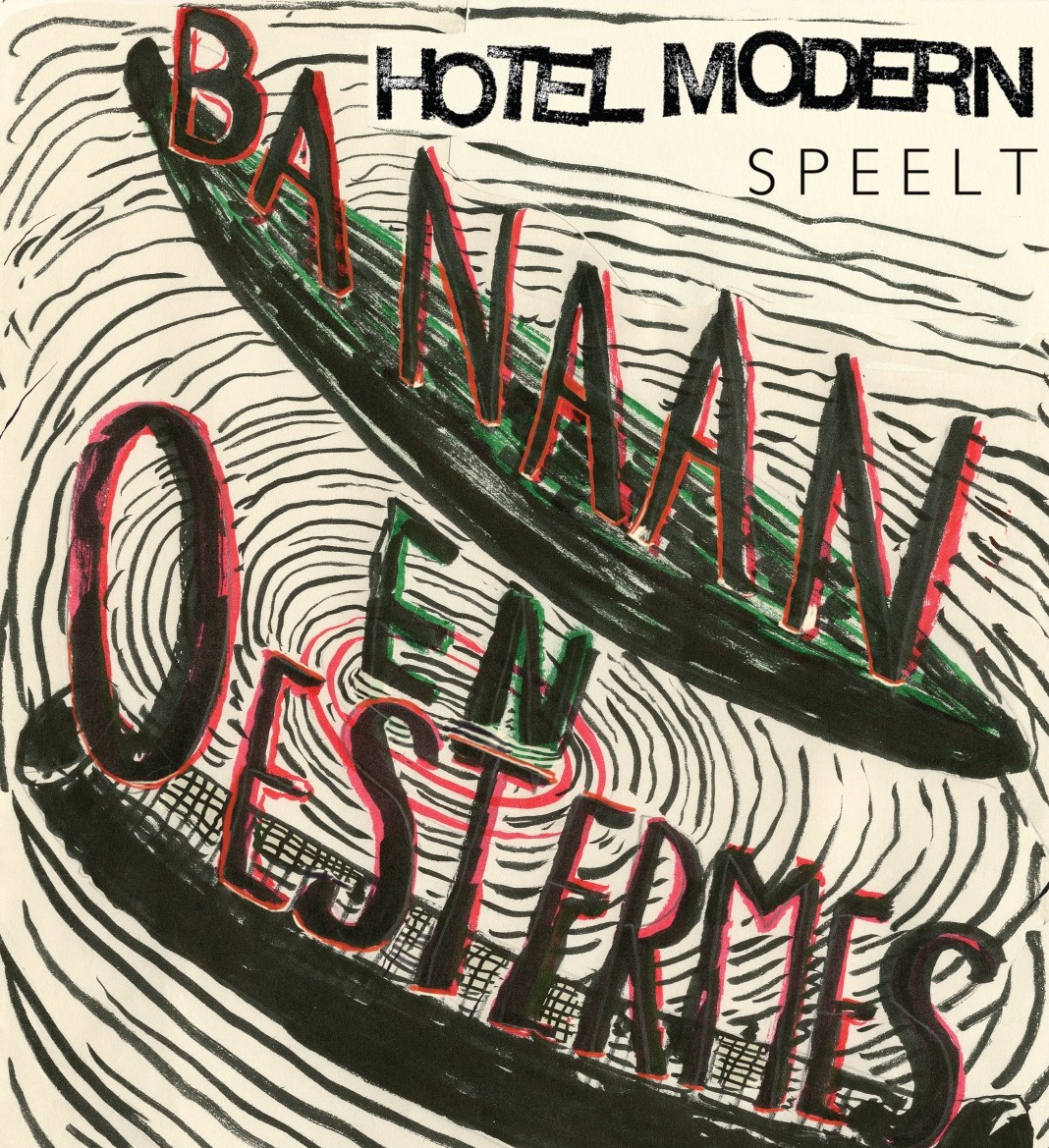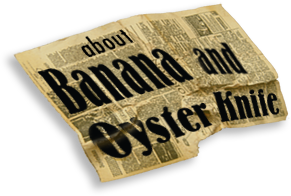


- Premiere Year 2017
A museum built of cardboard rises from the stage, and on display are all the things that humanity produces: anything from toilet brushes to jars of peanut butter and from soldiers helmets to fragments of human bones. Three performers are making frantic efforts to categorise and group objects from this huge mound of stuff.
In the process they create fascinating still lives, discover what connects cauliflowers, skulls and bath sponges, squeeze poetry from a Toilet Duck bottle, and arrange a meeting between a balloon and a cactus. Their dizzying quest for ever more group sculptures leads them to the discovery of the wild, swirling source of human intelligence and creativity.
"In Banana and Oyster Knife everything happens on a scale of one to one, with a preference for light horror and wacky humor. This performance offers cheerful image theatre for designers and other viewers." (Theaterkrant)
"In a minimalist decor in which cardboard boxes serve as pedestal, the three members of Hotel Modern associatively group all kinds of stuff on color, shape and meaning, thereby creating witty and sometimes poetic stories. Effortlessly everyday objects transform into art. When one performer chooses a cauliflower, the next one comes with a tennis ball and the last one adds a bread roll. In a series of cheerful and sometimes wistful images a range of human creations is exhibited, from a stuffed baby deer to a bottle of Toilet Duck. Together they form a beautiful, graceful ode to human striving." (Volkskrant)
"Banana and Oyster Knife possesses the theater group's alienating style and humor. A stream of images, association upon association, is played out as a competition in creativity in which the performers try to outdo each other time and again." (NRC Handelsblad)
"Hotel Modern could have easily relied on their success formula. The choice to not meet expectations and choose another path shows great courge. Banana and Oyster Knife offers an experiment that many theater companies no longer deem necessary or dare to make. For that reason alone, this performance is worth the visit." (8Weekly)

-
Reviews & articles
-
Cheerful theater, with a distinct preference for light horror and outlandish humour
We rarely pay attention to the things that surround us, but Hotel Modern is determined to put a stop to that. At the left and rear of the stage stand cardboard boxes that hold the promise of the things they contain. Centre stage we see six boxes serving as plinths. Herman Helle, Arlène Hoornweg and Pauline Kalker take it in turns to place objects on them, and while one of them makes their move the others consider their response, as if this is a game of chess.
by Dick van Teylingen, Theaterkrant Read the whole review
Surrealism, according to De Lautréamont, is as ‘beautiful as the chance meeting on a dissecting table of a sewing machine and an umbrella’.’ If he was right, there is surrealism galore in Banana and Oyster Knife, the new play by Hotel Modern. This time the theatre company have left their cameras and projection screens at home – and they don’t disappoint.
Humans surround themselves with things. Lots and lots of things. We rarely pay attention to many of them, but Hotel Modern is determined to put a stop to that. At the left and rear of the stage stand two high walls of boxes – cardboard boxes that hold the promise of the things they contain. Centre stage is the battleground, with six other boxes serving as plinths. Herman Helle, Arlène Hoornweg and Pauline Kalker take it in turns to place objects on them, and while one of them makes their move the others consider their response, as if this is a game of chess.
They begin – logically and fittingly – with brains (we later discover that they are actually cauliflowers). These are followed by an assortment of objects: balls, jars of sausages, asparagus, peanut butter, toilet rolls, soldiers’ helmets, washing-up brushes, an indoor plant, skulls, balloons, boots, stuffed animals, a toilet duck, and one of those curious cactuses with a red ball on top – to name but a few. Many more appear from the boxes large and small. The collection seems to be inexhaustible.
Soon enough, the players move on from single objects to combinations. Objects and shapes start competing with each other, becoming interrelated, and conflicting with or echoing one another. The players ponder long and hard on what new combination should follow. If it works, they glow with a sense of triumph, and occasionally applaud one another. One unusual combination follows another. My daughter, who has a well-tuned understanding of such things, said, ‘You could take a photo at any moment, and you’d always have a good picture.’
Hotel Modern have well-known the world over for their use of live animation in theatre, with plays in which events such as the horrors of the world wars are enacted at doll-house size. Using scale models in which the actors manipulate self-made puppets, objects and anything else they need to tell their story, they film the action with small cameras and project these scenes onto a large screen.
In Banana and Oyster Knife everything takes place at a scale of 1:1. The company displays a distinct preference for light horror and outlandish humour, such as in the fairy tale that Herman Helle tells. I suspect that the imaginative mind of model builder, absurdist theatre maker Helle had a large part to play in the development of this piece. Photographs of Helle are on display in the foyer, showing him in the foreground and something meaningful in the background – they are selfies, but from a time before that word existed.
Only two things are missing from this dynamic museum of everyday objects: a banana and an oyster knife.
4-11-2017
-
A courageous exploration of form
I notice that I start seeing the objects as a child would: not as mere objects, but as items that can be used to make all sorts of other things. […] Choosing to take another path and not satisfy expectations is a courageous move. Banana and Oyster Knife is the type of exploration of form that many experienced companies would either not consider worthwhile or not have the courage to embark on. Even if only for that reason, this piece is well worth seeing.
by Jeroen van Wijhe, 8Weekly Read the whole review
Hotel Modern don’t use cameras in Banana and Oyster Knife – and the essence of the company’s approach to dramatic structure is all the clearer for it.
Child’s play
Devoted Hotel Modern audiences already have a fair idea of what to expect from the company: the actors use cameras, sound effects and countless objects to create illusions that they bring to life on a projection screen. Over the years the group has used this approach to build up a substantial body of work, ranging from the comical Shrimp Tales to Kamp, a horrific portrayal of life in a concentration camp. In Banana and Oyster Knife, however, there is not a camera to be seen. For this play Hotel Modern have abandoned their usual formula to experiment with a form of object theatre that takes place exclusively on the stage floor.The set for Banana and Oyster Knife seems simple enough. We see six blocks on which objects stand. The actors start playing a game, positioning new objects and juxtaposing them, one by one. The actors are like chess players as they consider their next move. It appears that the aim is to create a combination of objects that is as tall possible. I notice that I start seeing the objects as a child would: not as mere objects, but as items that can be used to make all sorts of other things. After a number of moves, the artwork is ready. The players then look at one another, applaud, and start making new combinations of objects. As it progresses in this way, the tableau becomes a commentary on art: on its absurd aspects, on the scene’s self-contamination and on its fleeting nature – art is there for a moment, and then it disappears.
Life in lifeless things
The cast then abandon the focus on stacking objects, giving them the freedom to make sculptures from the objects. Once again Hotel Modern succeed in getting us to see things that aren’t there: once it’s stuffed into a skull, a cauliflower becomes a brain; a jar of peanut butter looks a lot less tasty when a toilet brush is dipped into it. A brief gasp of shock can be heard from the audience when the actors stab stuffed animals – we know it’s not real, but we fall for it anyway. Ultimately the focus shifts to the actors themselves as they attempt to transform themselves into objects. This yields some splendid moments – especially when Arlène Hoornweg and Pauline Kalker seem to disappear into their costumes – but they are never quite as engaging as the evocations of life in lifeless things. Their use of a more fundamental form in this play only underlines that this – and the humour and sense of wonder it engenders – is the company’s trump card.Hotel Modern could have chosen to rely on their successful formula. They are the only people in the Netherlands making theatre in this way, and they attract audiences that are well acquainted with the company’s earlier work. Choosing to take another path and not satisfy expectations is a courageous move. Banana and Oyster Knife is the type of exploration of form that many experienced companies would either not consider worthwhile or not have the courage to embark on. Even if only for that reason, this piece is well worth seeing.
13-11-2017
-
Tourdates Banana and Oyster Knife
- View all our tourdates in the agenda
-
Makers
-
Concept, stage design and cast members Pauline Kalker, Herman Helle, Arlène Hoornweg Assistant Maartje van den Brink Technician André Goos Assistant technician Joost ten Hagen Poster image and illustrations Harriet van Reek Graphic design Sibe Kokke Photography Bas Czerwinski Subsidy Performing Arts Fund NL, City of Rotterdam









